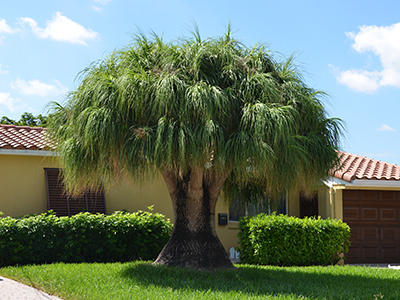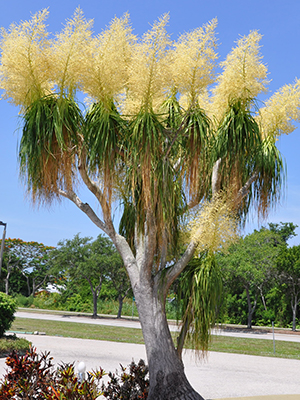Ponytail "Palm"

Tree-sized ponytail plant (Beaucarnea recurvata) outside a home in South Florida. ©Stephen Brown, UF/IFAS Extension Lee County.
The ponytail "palm" (Beaucarnea recurvata) might not be a real palm, but it is a great South Florida plant. This tree-sized succulent is a member of the agave family and is named for the long, delicate leaves that drape over the branches, giving it a "ponytail" effect.
Characteristics
The ponytail palm makes a great specimen plant. In South Florida, it's mostly seen on front lawns for its dramatic effect. Being from the dry regions of Mexico, ponytail palm is well suited for rock gardens or for the cooler parts of the state, as a container houseplant.
The plant commonly doesn't grow more than 20 feet tall. The base of the trunk forms a woody, light brown and very broad stem-root called a caudex measuring up to 7 feet across. Branches are formed just above the top of the caudex but more commonly several feet above the caudex from one or more main trunks. The light green leaves are long and thin and cascade in tufts at the ends of the few branches. Throughout the year, the older bottom leaves dry and eventually fall away from the tuft.
Long, showy, creamy-white inflorescence appear above the foliage on some or all of the branches in spring or summer. They persist for several weeks and are at first erect but droop with age or when becoming heavy with small capsules. Some plants will flower two or even three times per year.
Planting and Care
South Florida gardeners can plant ponytail palm in full or part sun in well-drained soil; it's hardy only in zones 10A to 11. If you are moving a plant that has been growing inside to the outdoors, be sure you transition it slowly. Plants need to be gradually exposed to the different temperature and sun exposure that the outdoors have to offer.
For a neater appearance, seed heads can be gently pulled away from the plant, if you can reach them safely.
The plant easily establishes and is quite drought tolerant throughout the year. However, supplemental irrigation in the dry season produces darker green leaves and less tendency for leaf fall. This is mostly a pest-free plant, although rot of the caudex and tips of branches have been reported.

A newly flowering ponytail palm. ©Stephen Brown, UF/IFAS Extension Lee County.

